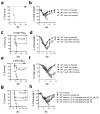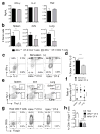Direct IL-6 Signals Maximize Protective Secondary CD4 T Cell Responses against Influenza
- PMID: 27647834
- PMCID: PMC5101150
- DOI: 10.4049/jimmunol.1600033
Direct IL-6 Signals Maximize Protective Secondary CD4 T Cell Responses against Influenza
Abstract
Memory T cells can often respond against pathogens that have evaded neutralizing Abs and are thus key to vaccine-induced protection, yet the signals needed to optimize their responses are unclear. In this study, we identify a dramatic and selective requirement for IL-6 to achieve optimal memory CD4 T cell recall following heterosubtypic influenza A virus (IAV) challenge of mice primed previously with wild-type or attenuated IAV strains. Through analysis of endogenous T cell responses and adoptive transfer of IAV-specific memory T cell populations, we find that without IL-6, CD4+, but not CD8+, secondary effector populations expand less and have blunted function and antiviral impact. Early and direct IL-6 signals to memory CD4 T cells are required to program maximal secondary effector responses at the site of infection during heterosubtypic challenge, indicating a novel role for a costimulatory cytokine in recall responses.
Copyright © 2016 by The American Association of Immunologists, Inc.
Figures








Similar articles
-
CCR2 Regulates Vaccine-Induced Mucosal T-Cell Memory to Influenza A Virus.J Virol. 2021 Jul 12;95(15):e0053021. doi: 10.1128/JVI.00530-21. Epub 2021 Jul 12. J Virol. 2021. PMID: 33952647 Free PMC article.
-
Memory CD4 T cells direct protective responses to influenza virus in the lungs through helper-independent mechanisms.J Virol. 2010 Sep;84(18):9217-26. doi: 10.1128/JVI.01069-10. Epub 2010 Jun 30. J Virol. 2010. PMID: 20592069 Free PMC article.
-
Intranasal Introduction of Fc-Fused Interleukin-7 Provides Long-Lasting Prophylaxis against Lethal Influenza Virus Infection.J Virol. 2015 Dec 9;90(5):2273-84. doi: 10.1128/JVI.02768-15. J Virol. 2015. PMID: 26656713 Free PMC article.
-
Protective CD8 T cell-mediated immunity against influenza A virus infection following influenza virus-like particle vaccination.J Immunol. 2013 Sep 1;191(5):2486-94. doi: 10.4049/jimmunol.1300954. Epub 2013 Jul 24. J Immunol. 2013. PMID: 23885108 Free PMC article.
-
Memory CD4 T cells in influenza.Curr Top Microbiol Immunol. 2015;386:399-421. doi: 10.1007/82_2014_401. Curr Top Microbiol Immunol. 2015. PMID: 25005927 Free PMC article. Review.
Cited by
-
IL-6 Promotes T Cell Proliferation and Expansion under Inflammatory Conditions in Association with Low-Level RORγt Expression.J Immunol. 2018 Nov 15;201(10):2934-2946. doi: 10.4049/jimmunol.1800016. Epub 2018 Oct 12. J Immunol. 2018. PMID: 30315140 Free PMC article.
-
Memory CD4 T cell-derived IL-2 synergizes with viral infection to exacerbate lung inflammation.PLoS Pathog. 2019 Aug 14;15(8):e1007989. doi: 10.1371/journal.ppat.1007989. eCollection 2019 Aug. PLoS Pathog. 2019. PMID: 31412088 Free PMC article.
-
Influenza Vaccine-Induced CD4 Effectors Require Antigen Recognition at an Effector Checkpoint to Generate CD4 Lung Memory and Antibody Production.J Immunol. 2020 Oct 15;205(8):2077-2090. doi: 10.4049/jimmunol.2000597. Epub 2020 Sep 14. J Immunol. 2020. PMID: 32929040 Free PMC article.
-
Inflammation, Immune Senescence, and Dysregulated Immune Regulation in the Elderly.Front Aging. 2022 Apr 27;3:840827. doi: 10.3389/fragi.2022.840827. eCollection 2022. Front Aging. 2022. PMID: 35821823 Free PMC article. Review.
-
T-bet optimizes CD4 T-cell responses against influenza through CXCR3-dependent lung trafficking but not functional programming.Mucosal Immunol. 2019 Sep;12(5):1220-1230. doi: 10.1038/s41385-019-0183-z. Epub 2019 Jul 5. Mucosal Immunol. 2019. PMID: 31278374 Free PMC article.
References
-
- Tan AC, Mifsud EJ, Zeng W, Edenborough K, McVernon J, Brown LE, Jackson DC. Intranasal administration of the TLR2 agonist Pam2Cys provides rapid protection against influenza in mice. Mol Pharm. 2012;9:2710–2718. - PubMed
Publication types
MeSH terms
Substances
Grants and funding
LinkOut - more resources
Full Text Sources
Other Literature Sources
Research Materials

